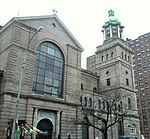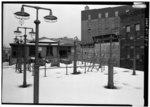143rd Street station
1886 establishments in New York (state)1955 disestablishments in New York (state)Bronx building and structure stubsDefunct New York City Subway stations located abovegroundFormer elevated and subway stations in the Bronx ... and 6 more
IRT Second Avenue Line stationsIRT Third Avenue Line stationsMott Haven, BronxNew York City railway station stubsRailway stations closed in 1955Railway stations in the United States opened in 1886
The 143rd Street station was a station on the demolished IRT Third Avenue Line in the Bronx, New York City. It was originally opened on May 23, 1886, by the Suburban Rapid Transit Company, one week after replacing the recently opened 133rd Street station as the northern terminus of the Third Avenue Line. This station had two tracks and one island platform, and was also served by trains of the IRT Second Avenue Line until June 11, 1940. This station closed on May 12, 1955, with the ending of all service on the Third Avenue El south of 149th Street.
Excerpt from the Wikipedia article 143rd Street station (License: CC BY-SA 3.0, Authors).143rd Street station
East 143rd Street, New York The Bronx
Geographical coordinates (GPS) Address Nearby Places Show on map
Geographical coordinates (GPS)
| Latitude | Longitude |
|---|---|
| N 40.812416666667 ° | E -73.921805555556 ° |
Address
East 143rd Street 352
10454 New York, The Bronx
New York, United States
Open on Google Maps






